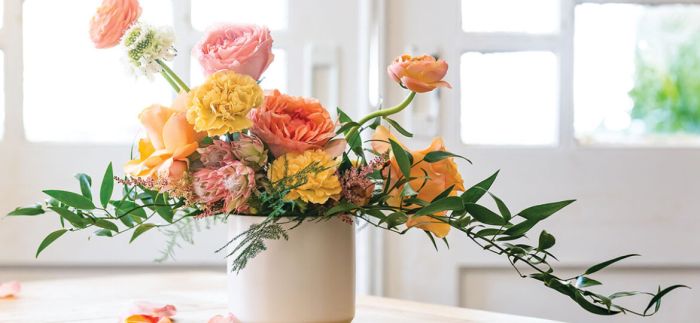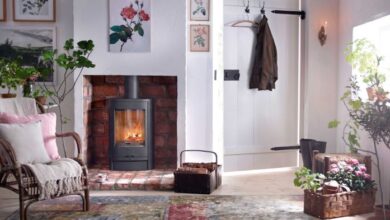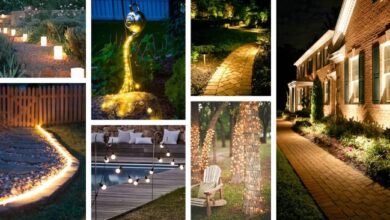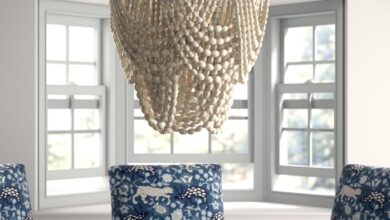Spring floral arrangements for homes
Spring floral arrangements for homes offer a delightful way to brighten your living space and welcome the season’s renewal. From the vibrant hues of tulips to the delicate fragrance of hyacinths, spring flowers provide endless possibilities for creating stunning displays. This guide explores various aspects of crafting beautiful spring arrangements, covering flower selection, arrangement styles, container choices, color palettes, and step-by-step tutorials for creating your own masterpieces.
We’ll delve into the art of floral design, examining principles of balance, scale, and proportion to ensure your arrangements are visually appealing. We’ll also explore diverse container options, from classic vases to repurposed items, and how to incorporate seasonal elements beyond flowers to enhance the overall theme. Whether you’re a seasoned florist or a beginner, this comprehensive guide will equip you with the knowledge and inspiration to create breathtaking spring floral arrangements for your home.
Popular Spring Flowers for Home Arrangements
Spring’s arrival brings a vibrant array of blooms perfect for brightening up any home. Choosing the right flowers for your arrangement depends on factors such as desired color palette, bloom time, and care requirements. This section explores some popular spring flower choices and their characteristics.
Spring Flower Varieties and Their Characteristics
Five popular spring flowers frequently used in home arrangements include tulips, daffodils, hyacinths, ranunculus, and lilies. Each boasts unique color palettes and bloom times, offering diverse options for creating stunning floral displays. Tulips, for example, are available in a wide spectrum of colors, from classic reds and yellows to vibrant purples and oranges, while daffodils are often associated with sunny yellows but also come in white and even bicolors.
Hyacinths offer a strong, sweet fragrance and come in shades of purple, pink, white, and blue. Ranunculus are known for their densely layered petals and diverse color options, ranging from classic white and yellow to deep reds and oranges. Finally, lilies, while technically blooming slightly later in some areas, often make their appearance in early to mid-spring, offering elegant trumpet-shaped flowers in a range of colors, including white, pink, orange, and yellow.
Bloom times vary slightly depending on geographic location and specific cultivar.
Longevity and Care of Tulips, Daffodils, and Hyacinths
Tulips, daffodils, and hyacinths, while all popular spring choices, differ in their longevity and care requirements. Tulips, known for their elegant cup-shaped blooms, tend to last for a week or so in a vase, often drooping slightly after a few days. Daffodils, with their cheerful trumpet-shaped flowers, generally last a bit longer, up to 10 days, but their strong sap can affect the longevity of other flowers in a mixed arrangement.
Hyacinths, with their dense clusters of small bell-shaped flowers and strong fragrance, can also last approximately a week. Proper care, including using clean vases, fresh water, and flower food, extends the life of all three. Removing wilting blooms can also help to prolong the arrangement’s overall beauty.
Spring Flower Characteristics Table
| Flower Name | Color Variations | Bloom Time | Care Tips |
|---|---|---|---|
| Tulips | Red, yellow, orange, pink, purple, white, and many bi-colors | Late March – May | Use cool water, flower food, and recut stems daily. Avoid direct sunlight. |
| Daffodils | Yellow, white, orange, bicolors | March – April | Use cool water, flower food, and recut stems. Avoid placing with other flowers immediately after cutting. |
| Hyacinths | Purple, pink, white, blue | March – April | Use cool water, flower food, and recut stems. Ensure adequate water level to keep the bulbs moist. |
| Ranunculus | White, yellow, orange, pink, red, purple | March – May | Use cool water, flower food, and recut stems. Remove lower leaves that would be submerged in water. |
| Lilies | White, pink, orange, yellow | April – June (depending on variety and location) | Use cool water, flower food, and recut stems. Remove pollen-bearing anthers to prevent staining. |
Arrangement Styles and Design Principles: Spring Floral Arrangements For Homes
Creating stunning spring floral arrangements involves understanding various styles and design principles. The right style can dramatically impact the overall feel of your home décor, transforming a simple arrangement into a captivating centerpiece. Mastering design principles ensures your creation is not only beautiful but also visually balanced and harmonious.
Three Distinct Spring Floral Arrangement Styles
Spring offers a vibrant palette of flowers, lending themselves beautifully to a range of arrangement styles. Consider the overall aesthetic you wish to achieve when selecting a style for your floral display. Each style evokes a different mood and suits various home décor themes.
- Cascading Arrangements: These arrangements are characterized by their flowing, downward movement. Flowers are strategically placed to create a sense of movement and fluidity. They often incorporate a variety of textures and heights, with longer stems cascading gracefully over the edges of the container. Cascading arrangements are particularly effective in larger spaces, adding a dramatic touch to a room.
- Modern Arrangements: Modern arrangements prioritize clean lines, minimalist aesthetics, and a sense of sophistication. They typically feature a limited color palette, often focusing on a single striking hue or a combination of two complementary colors. The emphasis is on showcasing the inherent beauty of the flowers themselves, rather than elaborate designs. Asymmetrical shapes and unexpected combinations of textures are common.
- Traditional Arrangements: Traditional arrangements often evoke a sense of classic elegance and formality. They tend to be more symmetrical and structured, with flowers arranged in a balanced and harmonious manner. A variety of flower types and colors are frequently used, creating a rich and visually appealing display. Traditional arrangements often feature a focal point, such as a larger bloom or a cluster of flowers, surrounded by smaller blooms and greenery.
Principles of Balance, Scale, and Proportion in Floral Arrangements
The visual appeal of a floral arrangement hinges on the successful application of balance, scale, and proportion. These principles work together to create a harmonious and aesthetically pleasing composition.
- Balance: Balance refers to the visual weight distribution within the arrangement. Symmetrical balance involves mirroring elements on either side of a central axis, creating a formal and structured look. Asymmetrical balance, on the other hand, achieves equilibrium through the use of contrasting elements with different visual weights. A large, dark flower on one side might be balanced by several smaller, lighter flowers on the other.
- Scale: Scale refers to the size of the arrangement in relation to its surroundings. A small arrangement might be appropriate for a small table, while a larger arrangement might be needed to fill a larger space. The scale of the flowers within the arrangement should also be considered; a mix of sizes and textures generally creates more visual interest.
- Proportion: Proportion relates to the relative sizes of different elements within the arrangement. The flowers, foliage, and container should all be in proportion to each other. A disproportionately large container, for example, can overshadow the flowers and detract from the overall design. The goal is to create a sense of harmony and unity among all components.
Three Spring Floral Arrangement Designs
These designs showcase the different styles and color palettes discussed earlier.
- Design 1: Cascading Spring Romance (Cascading Style, Pastel Color Palette): This arrangement uses a mix of light pink roses, lavender tulips, and white lilies, spilling over the edges of a rustic wooden basket. The delicate pastel shades create a romantic and feminine feel. Baby’s breath is strategically placed to add texture and fill gaps. Longer stems of roses and tulips are arranged to cascade gracefully, while the lilies are positioned towards the center for visual emphasis.
- Design 2: Modern Spring Minimalism (Modern Style, Monochromatic Color Palette): This arrangement features a selection of deep purple hyacinths and vibrant green eucalyptus in a sleek, clear glass vase. The monochromatic color palette, focusing on varying shades of purple and green, creates a clean and modern aesthetic. The hyacinths are arranged asymmetrically, with some stems leaning to one side to create visual interest. The eucalyptus adds texture and height, balancing the compact hyacinths.
- Design 3: Traditional Spring Abundance (Traditional Style, Multicolored Palette): This arrangement showcases a variety of spring blooms in a classic ceramic vase. Bright yellow daffodils, orange tulips, and deep red poppies are clustered together, creating a vibrant and cheerful display. The arrangement is relatively symmetrical, with flowers of similar heights placed opposite each other. Greenery, such as ferns and ivy, is used to fill in spaces and provide a contrast in texture.
Vases and Containers for Spring Arrangements

Source: flowermag.com
Choosing the right vase or container is crucial for showcasing the beauty of your spring floral arrangements. The vessel’s shape, material, and color can significantly impact the overall aesthetic, complementing or contrasting with the flowers’ vibrancy and delicate forms. Careful consideration of these elements will elevate your spring displays from simple arrangements to stunning focal points.
Examples of Vases and Containers for Spring Arrangements
The selection of a vase or container should harmonize with both the flowers and the overall decor of your home. Here are five diverse examples illustrating the range of options available:
- Classic Glass Vase: A clear glass vase, perhaps with a slender, elegant neck and a slightly flared base, allows the flowers’ colors and textures to shine. The transparency provides a clean, modern aesthetic, ideal for showcasing minimalist arrangements or delicate blooms like tulips or daffodils. Imagine a tall, cylindrical glass vase filled with a cascade of white hyacinths.
- Ceramic Vase with a Textured Surface: A ceramic vase with a rustic, textured surface, such as a crackled glaze or a hand-thrown design, offers a more organic and artisanal feel. Earthy tones like terracotta or muted greens complement spring blooms beautifully. Picture a low, wide ceramic bowl in a warm terracotta hue, filled with a vibrant mix of daffodils, hyacinths, and anemones.
- Modern Metal Vase: A sleek, metallic vase, perhaps in brushed silver or copper, provides a contemporary contrast to the softness of spring flowers. The reflective surface adds a touch of sophistication and can enhance the colors of the flowers. Envision a polished copper vase, its smooth curves holding a bouquet of vibrant purple and pink hyacinths.
- Vintage Porcelain Pitcher: A vintage porcelain pitcher, with delicate floral patterns or a pastel color, adds a touch of nostalgic charm. The slightly irregular shape and unique details create a visually interesting base for a spring arrangement. Imagine a pale blue porcelain pitcher, its handle elegantly curved, holding a simple yet elegant arrangement of white tulips and sprigs of greenery.
- Contemporary Sculptural Vase: A contemporary vase with an unusual shape or bold design can become a statement piece itself. Sculptural vases in materials like glazed ceramic or resin can be dramatic and modern, adding a unique artistic element to the floral arrangement. Picture a minimalist, geometric vase in matte black holding a single, striking branch of cherry blossoms.
Comparing Visual Impacts of Different Container Materials
Glass, ceramic, and metal containers each offer distinct visual impacts. Glass offers transparency, showcasing the flowers and stems clearly, providing a clean, modern feel. Ceramic vases provide a more textured, often warmer feel, with a range of colors and finishes available to complement or contrast with the flowers. Metal vases, especially in polished finishes, offer a modern, reflective quality, adding a touch of sophistication and potentially altering the perceived color of the flowers through reflection.
Unique Container Ideas Beyond Traditional Vases
Stepping outside the realm of traditional vases can unlock creative possibilities for your spring floral arrangements.
- Teacups: Small, mismatched teacups create a charming and whimsical display, particularly suitable for petite arrangements of single blooms or delicate sprigs. The variety of shapes, sizes, and patterns adds a playful touch.
- Mason Jars: Rustic mason jars offer a simple, versatile, and affordable option. Their clear glass allows the flowers to be seen clearly, and their cylindrical shape is adaptable to various arrangements. Adding twine or lace can enhance their rustic charm.
- Repurposed Tin Cans: Cleaned and painted tin cans, perhaps with a distressed or patterned finish, provide an eco-friendly and unique alternative. Their sturdy nature allows for heavier blooms and provides a modern, industrial touch.
- Old Watering Cans: A vintage watering can, especially one with a charming patina, makes a delightful and unexpected container. Its spout and handle add character, and the size accommodates a larger arrangement.
- Hollowed-out Gourds: Dried and cleaned gourds, with their natural textures and shapes, provide an organic and unique container, especially for arrangements with a rustic or autumnal-inspired feel (though still fitting thematically within the broader context of spring’s transition).
Color Palettes and Seasonal Themes
Spring floral arrangements offer a fantastic opportunity to infuse your home with the vibrancy and freshness of the season. Choosing the right color palette and incorporating seasonal elements beyond flowers can significantly impact the overall mood and aesthetic appeal of your arrangement. The careful selection of colors and complementary materials elevates a simple arrangement into a thoughtful expression of spring’s beauty.Spring color palettes, in particular, can dramatically alter the atmosphere of a room.
Whether aiming for a tranquil, energetic, or sophisticated feel, the choice of colors sets the stage for the entire arrangement. The inclusion of seasonal elements, such as branches, greenery, and ribbons, adds depth, texture, and a unique narrative to the design.
Pastel Spring Color Palettes, Spring floral arrangements for homes
Pastel shades evoke a sense of calm and serenity, perfectly reflecting the gentle awakening of spring. Think soft pinks, lavenders, baby blues, and creamy yellows. These hues create a delicate and romantic atmosphere, ideal for bedrooms or living spaces where a peaceful ambiance is desired. The soft, muted tones blend seamlessly with most interior décor styles, providing a tranquil backdrop to the flowers themselves.
Arrangements featuring pastel tulips, hydrangeas, and roses, perhaps accented with delicate sprigs of baby’s breath, exemplify this palette.
Vibrant Spring Color Palettes
In contrast to pastel palettes, vibrant spring colors exude energy and enthusiasm. Think sunny yellows, bright oranges, rich reds, and deep purples. This palette is perfect for creating a bold and cheerful statement in a kitchen, dining room, or entryway. The intensity of these colors commands attention and brings a lively energy to the space. Arrangements incorporating sunflowers, gerbera daisies, poppies, and vibrant ranunculus create a striking visual impact.
Monochromatic Spring Color Palettes
Monochromatic palettes, using various shades and tones of a single color, create a sophisticated and elegant look. For spring, consider a monochromatic arrangement in shades of pink, ranging from pale blush to deep rose. This approach allows the textures and forms of the flowers to take center stage, showcasing the subtle beauty of variations within a single color family.
Using different textures of flowers in similar shades, such as peonies, roses, and carnations, in varying shades of pink, would beautifully illustrate this palette.
Incorporating Seasonal Elements
Beyond flowers, incorporating natural elements like budding branches, fresh greenery, and textured ribbons significantly enhances the spring theme. Willow branches, for instance, add a delicate, flowing element, while pussy willow catkins introduce a soft, fuzzy texture. Greenery such as eucalyptus, ferns, or ivy provides a lush backdrop for the flowers, adding depth and visual interest. Finally, pastel-colored ribbons or twine can be subtly woven through the arrangement, adding a touch of elegance and tying the design together.
The careful selection and placement of these additional elements add layers of visual appeal and texture, elevating the overall aesthetic of the arrangement.
An Easter-Themed Floral Arrangement
Imagine a vibrant Easter arrangement in a rustic ceramic vase. The color scheme is a cheerful blend of sunny yellows, soft pinks, and pastel greens. The centerpiece consists of a cluster of bright yellow daffodils, surrounded by delicate pink tulips and sprigs of fresh green eucalyptus. Several fluffy white bunny tail grass adds a playful, textured element.
Small, speckled robin’s eggs are nestled amongst the flowers, adding a charming Easter touch. Finally, a pale yellow ribbon is tied around the vase’s neck, completing the festive arrangement. This arrangement exudes a joyful, celebratory spirit, perfect for welcoming spring and the Easter holiday.
DIY Spring Floral Arrangement Tutorials
Creating beautiful spring floral arrangements for your home doesn’t require professional skills or expensive supplies. With a little guidance and readily available materials, you can craft stunning displays to brighten your living spaces. These tutorials provide step-by-step instructions for creating both a simple bouquet and a more elaborate centerpiece.
Simple Spring Bouquet Arrangement
This tutorial details the creation of a charming spring bouquet using readily available flowers like tulips, daffodils, and hyacinths. The focus is on achieving a naturally elegant look without overly complex techniques.
- Gather your supplies: You’ll need fresh spring flowers (a mix of colors and textures is ideal), a sharp knife or floral shears, a bucket or vase, and optional floral tape or twine for binding.
- Prepare the flowers: Remove any lower leaves that would fall below the waterline in the vase to prevent bacterial growth. Cut the stems at an angle with sharp shears to maximize water absorption.
- Create the bouquet: Begin with your focal flower – perhaps a larger tulip or daffodil. Add other flowers around it, gradually building the bouquet. Vary the heights and angles of the stems for a natural, flowing look. Use your hand to hold the stems together as you work.
- Secure the bouquet (optional): If desired, use floral tape or twine to gently bind the stems together near the base. This helps maintain the bouquet’s shape.
- Arrange in a vase: Place the bouquet in your chosen vase. Adjust the stems to achieve the desired shape and balance. Add water to the vase, ensuring the stems are fully submerged.
Spring Centerpiece Arrangement
This tutorial focuses on creating a visually appealing centerpiece arrangement perfect for a dining or coffee table, utilizing a variety of spring blooms and greenery. The emphasis is on creating height and visual interest.
- Choose your container: Select a shallow bowl, a low vase, or a decorative tray as your base. The size and shape will dictate the overall scale and style of your arrangement.
- Prepare the flowers and greenery: As with the bouquet, prepare your flowers by removing lower leaves and cutting stems at an angle. Include a variety of greenery such as ferns, eucalyptus, or pussy willow for texture and visual depth.
- Create a foundation: Begin by arranging larger elements such as greenery or larger flowers to create a base for the arrangement. This provides structure and helps guide the placement of smaller flowers.
- Add focal flowers: Introduce your focal flowers – perhaps some brightly colored tulips or daffodils – strategically placing them to create visual interest and balance.
- Fill in with smaller flowers and greenery: Fill in any gaps with smaller flowers and greenery, creating a lush and full look. Vary the heights and textures for a dynamic effect.
- Adjust and refine: Step back and assess your arrangement from different angles. Adjust the placement of flowers and greenery as needed to achieve the desired balance and visual appeal.
Flower Preparation for Arrangement
Proper preparation of cut flowers is crucial for extending their lifespan and ensuring the arrangement looks its best. These techniques will help you maximize the beauty of your spring blooms.
- Cleaning: Remove any damaged or wilting petals or leaves. Gently rinse the flowers under cool running water to remove any dirt or debris.
- Trimming: Use sharp floral shears or a knife to cut the stems at a 45-degree angle. This increases the surface area for water absorption. Recut stems before placing them in water.
- Rehydrating: Before arranging, submerge the cut stems in a bucket of lukewarm water for at least 30 minutes to rehydrate them. This helps them recover from the stress of cutting and improves their longevity.
End of Discussion
Transforming your home with vibrant spring floral arrangements is a rewarding experience that brings the beauty of the season indoors. By carefully considering flower selection, arrangement style, container choice, and color palette, you can create stunning displays that reflect your personal style and enhance the ambiance of your living space. Remember to experiment with different techniques and embrace your creativity – the possibilities are endless! Enjoy the process of bringing the beauty of spring into your home.
FAQ Guide
How long do spring flowers typically last in an arrangement?
The longevity of spring flowers varies depending on the type of flower and proper care. Generally, you can expect them to last from 3 to 10 days.
What are some good tips for keeping cut flowers fresh?
Use clean vases, change the water daily, add flower food, and keep arrangements away from direct sunlight and heat sources. Trim the stems at an angle before placing them in water.
Can I use artificial flowers to supplement real flowers in a spring arrangement?
Yes, strategically incorporating artificial flowers can extend the life and visual appeal of your arrangement, especially if you’re combining them with real flowers that might wilt more quickly.
Where can I find unique vases or containers for spring arrangements?
Thrift stores, antique shops, and even your own home (repurposing teacups, jars, etc.) are great places to find unique and affordable containers. Online marketplaces also offer a wide selection.
How do I choose the right color palette for my spring arrangement?
Consider the overall mood you want to create. Pastels offer a soft and serene feel, while vibrant colors are energetic and bold. Monochromatic palettes offer elegance and sophistication.









